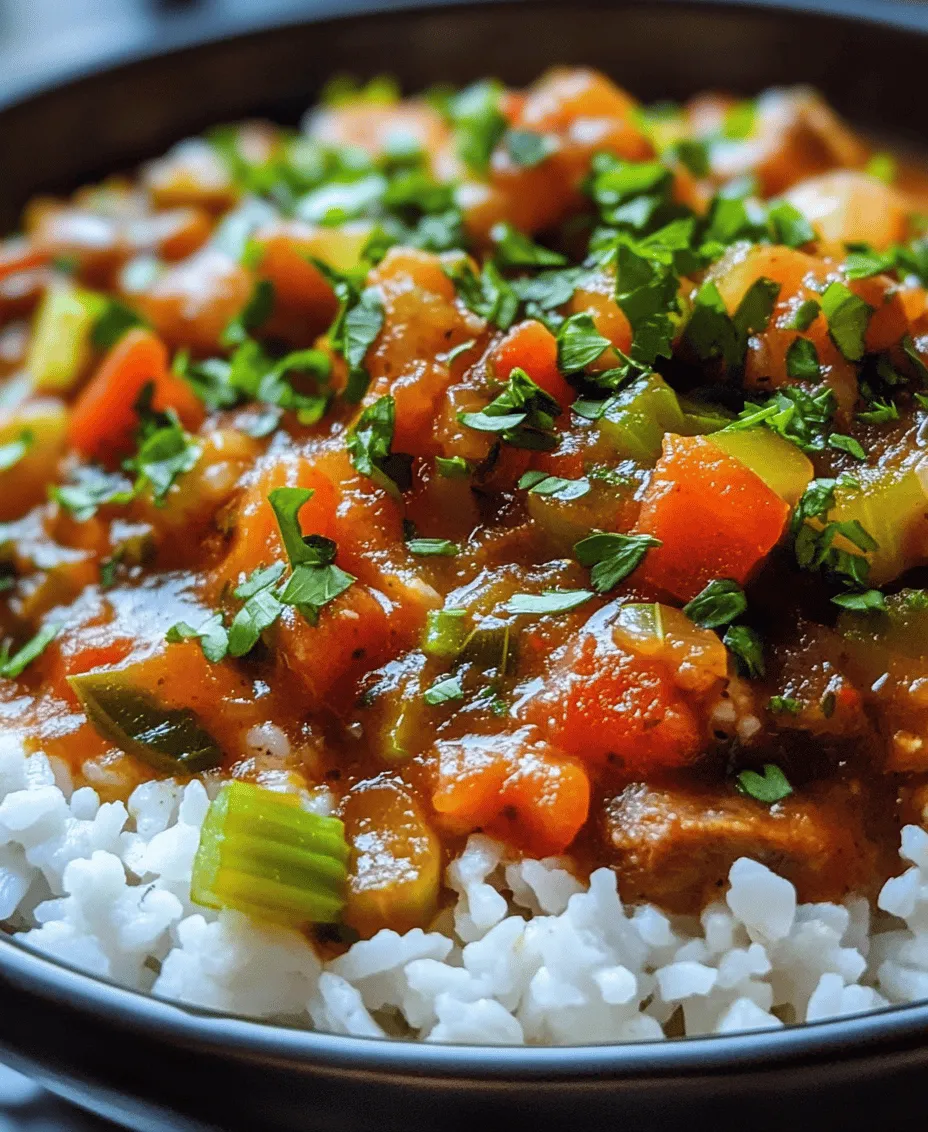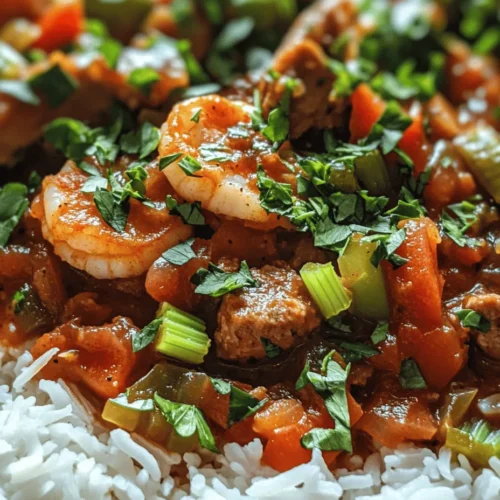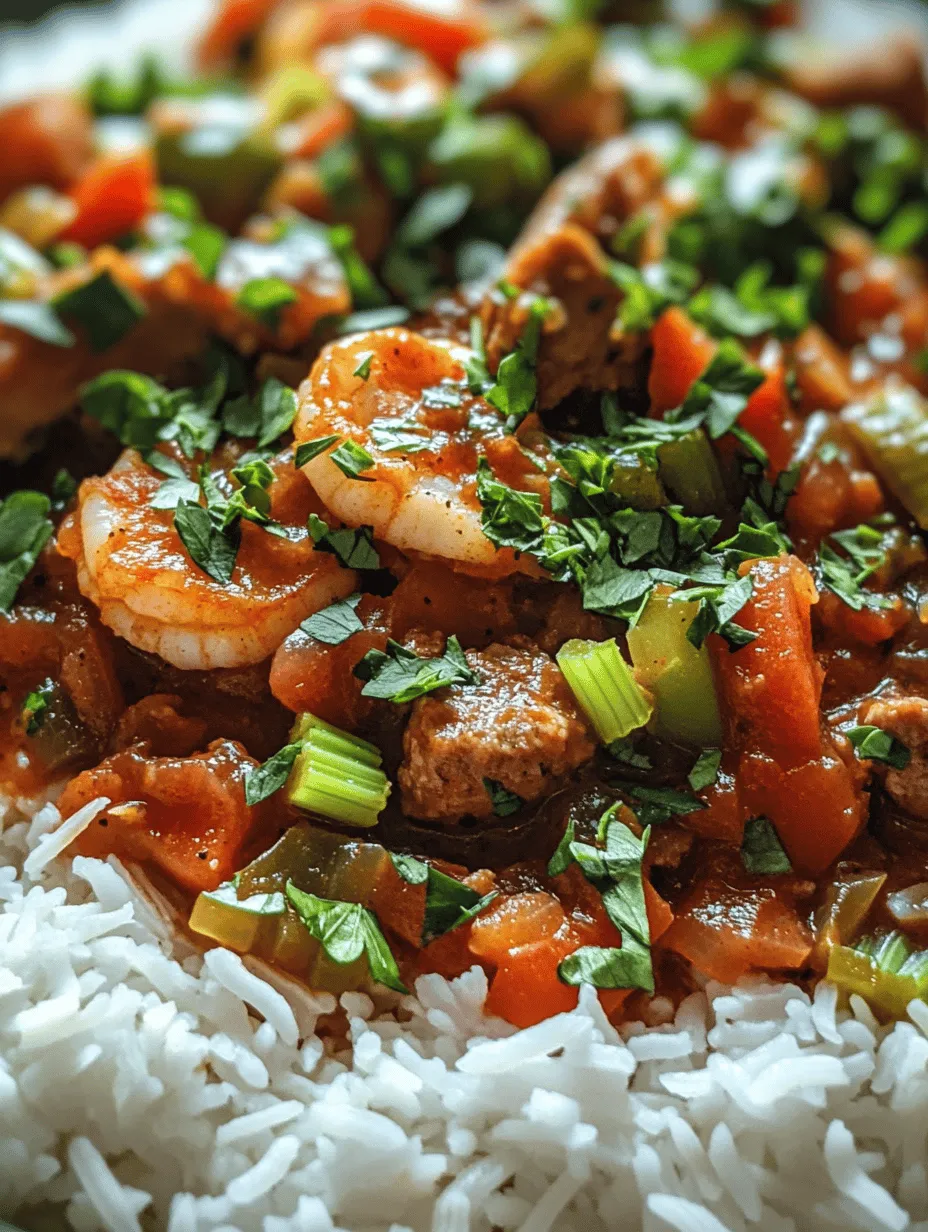Introduction
Gumbo is more than just a dish; it’s a culinary emblem of Southern heritage, an aromatic celebration of flavors that defines the vibrant culture of Louisiana. This hearty stew, with its rich history and robust taste, has become a staple in many households across the United States, particularly in the South. The beauty of gumbo lies not only in its ability to bring people together but also in its versatility—each family has their own cherished recipe passed down through generations, making it a personal and communal experience.
In this article, we’ll dive into a delightful version of gumbo that highlights two star ingredients: succulent shrimp and flavorful smoked sausage. This dish embodies the essence of Louisiana cooking, blending spices and textures to create a symphony of flavors in every bowl. Whether you’re hosting a family gathering or simply indulging in a comforting meal, this shrimp and sausage gumbo promises to impress and satisfy.
Gumbo is often the centerpiece of celebrations and family gatherings, serving as a delicious reminder of the cultural traditions that bring us together. From Mardi Gras festivities to Sunday dinners, this dish is more than just food; it’s a connection to the past and a means of creating new memories with loved ones.
Understanding Gumbo: A Culinary Journey
Historical Background of Gumbo
The origins of gumbo can be traced back to the early 18th century in Louisiana, where a melting pot of cultures converged—French, Spanish, African, and Native American influences all contributed to the development of this unique dish. The term “gumbo” itself is believed to derive from the West African word for okra, “ki ngombo,” which is one of the traditional thickeners used in the stew. This rich history has allowed gumbo to evolve over the years, resulting in numerous regional variations and personal adaptations.
As gumbo spread in popularity, it became a canvas for chefs and home cooks alike to express their creativity, leading to variations that incorporate different proteins and vegetables. While the classic seafood gumbo features shrimp, crab, and oysters, variations like chicken and sausage gumbo, or even vegetarian options, showcase the dish’s adaptability and universal appeal.
The Significance of the Roux
At the heart of every great gumbo is the roux—a critical element that serves as the flavor foundation for the dish. This mixture of flour and fat, typically oil or butter, is cooked slowly until it reaches a deep brown color, imparting a nutty flavor and richness to the stew. The process of making a roux requires patience and attention, as the goal is to achieve the perfect balance between flavor and consistency.
In traditional gumbo recipes, the roux can vary in color from light beige to dark chocolate brown, with darker roux providing a more complex flavor profile. This step is crucial, as it not only thickens the gumbo but also enhances the overall taste, making it a vital part of the cooking process that should not be rushed.
Varieties of Gumbo
Gumbo is a dish that celebrates variety and personal preference. While the seafood gumbo with shrimp and sausage is a beloved choice, other popular variations include:
– Chicken and Sausage Gumbo: A comforting option that replaces seafood with tender chicken pieces, offering a different flavor profile while still capturing the essence of gumbo.
– Vegetarian Gumbo: A plant-based twist on the classic, using an array of vegetables and legumes to create a satisfying and hearty stew without meat.
– Seafood Gumbo: Featuring a medley of fresh seafood such as shrimp, crab, and oysters, this version highlights the coastal flavors of Louisiana.
Each type of gumbo showcases the diversity of ingredients available and allows cooks to tailor the dish to their tastes, making it a beloved staple for any occasion.
Ingredients Breakdown
To prepare a truly remarkable shrimp and sausage gumbo, it’s essential to understand the ingredients that contribute to its rich flavor and satisfying texture. Below is a detailed breakdown of each key ingredient and its role in this delightful dish.
Shrimp
Shrimp is the star of this gumbo, providing a sweet and briny flavor that pairs beautifully with the other elements in the stew. Not only is shrimp delicious, but it’s also a great source of lean protein, vitamins, and minerals, making it a nutritious addition to your meal.
When selecting shrimp for this recipe, look for fresh, high-quality shrimp that are firm to the touch and have a mild ocean scent. Whether you choose large or medium shrimp, ensure they are deveined and peeled for convenience.
Smoked Sausage (Andouille)
Andouille sausage is another key player in this gumbo, offering a smoky flavor and a satisfying bite that complements the shrimp perfectly. This sausage is traditionally made from pork and seasoned with a variety of spices that infuse the gumbo with depth and warmth.
When choosing andouille sausage, opt for high-quality varieties that contain minimal fillers and preservatives. The robust flavor of the sausage enhances the overall taste of the gumbo, making it an indispensable ingredient.
The Holy Trinity
In Cajun and Creole cooking, the “Holy Trinity” refers to a mix of onions, bell peppers, and celery—three aromatic vegetables that form the flavor base for many dishes, including gumbo.
– Onions: Adds sweetness and depth to the dish.
– Bell Peppers: Contributes a slight crunch and a hint of bitterness.
– Celery: Provides a subtle earthiness and aroma.
Together, these vegetables create a fragrant foundation that enhances the overall flavor profile of the gumbo, making it essential for achieving authenticity.
Cajun Seasoning
Cajun seasoning is a blend of spices that brings the heat and flavor characteristic of Louisiana cuisine. Common ingredients include paprika, cayenne pepper, garlic powder, onion powder, thyme, and oregano. This seasoning not only adds a kick to the gumbo but also balances the richness of the roux and sausage.
When preparing gumbo, you can use store-bought Cajun seasoning or create your own blend to suit your taste preferences. This flexibility allows you to control the spice level, ensuring that your gumbo is as mild or as fiery as you desire.
Okra
Okra serves a dual purpose in gumbo: it acts as a thickening agent and adds texture to the dish. This unique vegetable has a distinctive flavor and a slightly slimy texture when cooked, which can help achieve that classic gumbo consistency.
Fresh okra is best used when in season, but frozen okra can also work well in this recipe. When preparing your gumbo, you can slice the okra into rounds and add it during the cooking process to allow it to soften and meld with the other ingredients.
Tips on Selecting the Freshest Ingredients
For an authentic and flavorful gumbo, the quality of your ingredients matters. Here are some tips for selecting the freshest components:
– Seafood: Buy shrimp from a reputable fishmonger or grocery store known for its seafood. Look for shrimp that are firm and have a clean, ocean-like smell.
– Sausage: Choose andouille sausage from local butchers or specialty stores to ensure it’s made with quality meat and spices.
– Vegetables: Select fresh vegetables that are vibrant in color and free from blemishes. The Holy Trinity should be crisp and fragrant.
– Herbs and Spices: Fresh herbs can elevate your gumbo, so consider using fresh parsley or thyme in addition to your Cajun seasoning.
Step-by-Step Instructions
Now that we have a solid understanding of the ingredients and their roles in our shrimp and sausage gumbo, let’s delve into the preparation process, starting with the crucial step of making the roux.
Preparation of the Roux
1. Gather Your Ingredients: For the roux, you will need equal parts flour and fat (such as vegetable oil or butter). A common starting point is ½ cup of each.
2. Heat the Fat: In a heavy-bottomed pot or Dutch oven, heat the oil over medium heat. Allow it to warm up before adding the flour.
3. Add the Flour: Gradually whisk in the flour, ensuring it combines well with the hot oil. This mixture should be smooth with no lumps.
4. Cook the Roux: Stir continuously as the roux cooks, keeping a close eye on the color. The goal is to achieve a deep brown color, which can take anywhere from 20 to 40 minutes. Patience is key here—do not rush the process, as a properly cooked roux is essential for developing the rich flavors of your gumbo.
5. Monitor the Heat: Adjust the heat as necessary to prevent the roux from burning. If it begins to smell burnt or develops an off-color, you will need to start over.
6. Achieve the Right Consistency: Once your roux reaches the desired color—think the shade of dark chocolate—remove it from the heat and prepare to incorporate the Holy Trinity of vegetables.
By mastering the roux, you’re well on your way to creating a gumbo that not only tastes authentic but also honors the rich culinary traditions of Louisiana. Be prepared to enjoy a dish that is bursting with flavor, texture, and warmth, inviting family and friends to gather around the table for a shared experience.

Sautéing the Vegetables: How to Achieve the Perfect Texture
The foundation of a great gumbo lies in the vegetables, commonly referred to as the “holy trinity” in Cajun and Creole cooking—onions, bell peppers, and celery. To achieve the perfect texture, follow these steps:
1. Choosing Your Vegetables: Use a mix of yellow onions, green bell peppers, and celery stalks. This combination adds depth and sweetness to your gumbo.
2. Chopping: Dice the vegetables evenly. This ensures they cook at the same rate, contributing to a harmonious flavor profile.
3. Sautéing: Heat two tablespoons of oil in a large, heavy-bottomed pot over medium heat. Add the chopped vegetables and sauté them for about 5-7 minutes, or until they become soft and translucent. Stir frequently to prevent burning and to promote even cooking.
4. Seasoning: As the vegetables sweat, add a pinch of salt and pepper to enhance their flavors. For an extra kick, consider adding a teaspoon of cayenne pepper or smoked paprika at this stage.
Perfectly sautéed vegetables should be tender yet still hold their shape, providing a flavorful base for your gumbo.
Cooking the Sausage: The Method for Enhancing Flavor
The sausage is a star player in your gumbo, adding a rich, smoky flavor that elevates the dish. Here’s how to cook it to perfection:
1. Choosing the Sausage: Andouille sausage is traditional for gumbo due to its spicy, smoky flavor. You can also use smoked sausage or kielbasa if you prefer.
2. Slicing: Cut the sausage into bite-sized pieces (about ½ inch) to ensure even cooking and easy incorporation into the gumbo.
3. Browning: In the same pot used for the vegetables, add another tablespoon of oil if needed, then add the sausage. Cook over medium-high heat for about 5-8 minutes until browned. This step is crucial as it builds a depth of flavor through the Maillard reaction.
4. Deglazing the Pot: Once the sausage is cooked, pour in a splash of chicken broth or water to deglaze the pot, scraping up any flavorful brown bits stuck to the bottom. This adds additional flavor to your gumbo.
The combination of sautéed vegetables and browned sausage creates a flavor-packed foundation that will make your gumbo truly irresistible.
Simmering the Gumbo: Balance of Flavors and Cooking Time Explained
With the vegetables and sausage ready, it’s time to bring the gumbo together. Simmering is where the magic happens, allowing the flavors to meld beautifully.
1. Adding Stock: Pour in 6 cups of chicken stock, stirring well to combine with the sautéed vegetables and sausage.
2. Seasoning: Add your seasonings—this includes bay leaves, thyme, Worcestershire sauce, and your choice of hot sauce for heat. Adjust the salt and pepper to taste.
3. Cooking Time: Bring the mixture to a gentle boil, then reduce the heat to low. Allow the gumbo to simmer uncovered for about 45 minutes to 1 hour. This slow cooking process enables the flavors to deepen and develop fully.
4. Stirring Occasionally: Stir the gumbo occasionally to prevent sticking and to ensure even cooking. Keep an eye on the consistency; if it becomes too thick, add more stock or water to reach your desired consistency.
This simmering phase is essential for achieving a well-balanced and flavorful gumbo.
Adding Shrimp: Signs to Look For to Ensure Perfectly Cooked Shrimp
Shrimp is typically added towards the end of the cooking process to avoid overcooking. Follow these steps to ensure your shrimp are perfectly cooked:
1. Choosing Shrimp: Opt for large or extra-large shrimp, preferably deveined and peeled. Fresh shrimp provides the best flavor, but frozen works well—just ensure they are thawed before use.
2. Timing: Add the shrimp during the last 5-7 minutes of simmering. This timing allows the shrimp to cook without becoming tough or rubbery.
3. Signs of Doneness: Watch for the shrimp to turn pink and opaque. They should curl slightly but not tightly. Remove the pot from heat as soon as they reach this stage—it’s better to slightly undercook them than to overdo it.
With the shrimp added, your gumbo is nearly complete, and the aroma will be tantalizing!
Serving Suggestions
Gumbo is best enjoyed with a few key accompaniments that enhance its flavors and provide a complete meal experience.
Ideal Accompaniments for Gumbo
– Rice: White or brown rice is a traditional side, serving as the perfect base to soak up the rich gumbo. Prepare it separately and serve it alongside or directly in the gumbo bowl.
– Bread: A crusty baguette or cornbread is a fantastic option for dipping and adding texture to your meal. The bread can also help balance the dish’s richness.
– Sides: Consider serving coleslaw or a simple green salad for a refreshing contrast to the hearty gumbo.
Presentation Tips
– Garnishing: Fresh parsley or green onions adds a pop of color and freshness. Sprinkle these over the gumbo just before serving.
– Serving Bowls: Traditional gumbo bowls or deep dishes add to the authenticity of the experience. Ladle the gumbo generously, allowing the vibrant colors of the ingredients to shine.
Pairing Beverages
– Beverage Suggestions: Gumbo pairs well with iced tea, especially sweet tea, or a light beer. For a non-alcoholic option, consider a refreshing lemonade or sparkling water.
Cultural Significance of Gumbo
Gumbo is more than just a meal; it embodies the spirit of community and tradition, especially in Southern culture.
Gumbo as a Symbol of Community and Sharing
In many Southern households, cooking gumbo is a communal affair. Families gather to prepare this dish, sharing stories and laughter as they chop vegetables and season the broth. Gumbo represents hospitality and warmth, often served during gatherings, holidays, and celebrations.
Variations by Family and Region
Each family has its own unique gumbo recipe, reflecting personal tastes, regional ingredients, and cultural influences. Some may include okra, while others might prefer filé powder, showcasing the dish’s adaptability. Personal anecdotes about family gumbo recipes highlight the importance of these culinary traditions in preserving heritage.
Celebrating Gumbo Festivals
Many cities in the Southern United States hold annual gumbo festivals, bringing together chefs and home cooks to celebrate this beloved dish. These events promote community spirit and creativity, allowing participants to showcase their unique recipes, compete for titles, and enjoy the vibrant culture surrounding gumbo.
Nutritional Information
Understanding the nutritional profile of gumbo can help you enjoy it as part of a balanced diet.
Breakdown of Calories, Proteins, Fats, and Carbohydrates
A serving of gumbo (approximately 1.5 cups) typically contains around:
– Calories: 350-400
– Protein: 20-25g
– Fat: 15-20g
– Carbohydrates: 30-35g
These values can vary based on the specific ingredients and portion sizes used.
Discussing Gumbo in a Balanced Diet
While gumbo can be rich due to its combination of meats and oils, it also offers a good source of protein and can be made with plenty of vegetables. Served alongside rice or bread, it can be a filling yet nutritious part of your meal.
Variations for Dietary Restrictions
For those with dietary restrictions, gumbo can be easily adapted:
– Gluten-Free: Ensure that the sausage is gluten-free and use a gluten-free thickener if desired.
– Low-Carb: Substitute rice with riced cauliflower or serve it without rice altogether for a lower-carb option.
– Vegetarian or Vegan: Replace meats with hearty vegetables or plant-based proteins, and use vegetable broth as the base.
Conclusion
There is a unique joy in crafting gumbo, a dish that represents comfort, community, and the rich history of Southern cooking. As you share this dish with friends and family, you’re not just serving a meal but also a piece of cultural heritage. Each pot of gumbo tells a story—of ingredients, traditions, and the joy of gathering around the table.
Embrace the cooking process, experiment with flavors, and don’t hesitate to make the recipe your own. Whether it’s your first time or you’re a seasoned gumbo maker, each attempt is an opportunity to create something special that can be shared and cherished. So gather your ingredients, roll up your sleeves, and prepare to enjoy a delightful journey into the heart of Southern cuisine with your very own gumbo galore!


